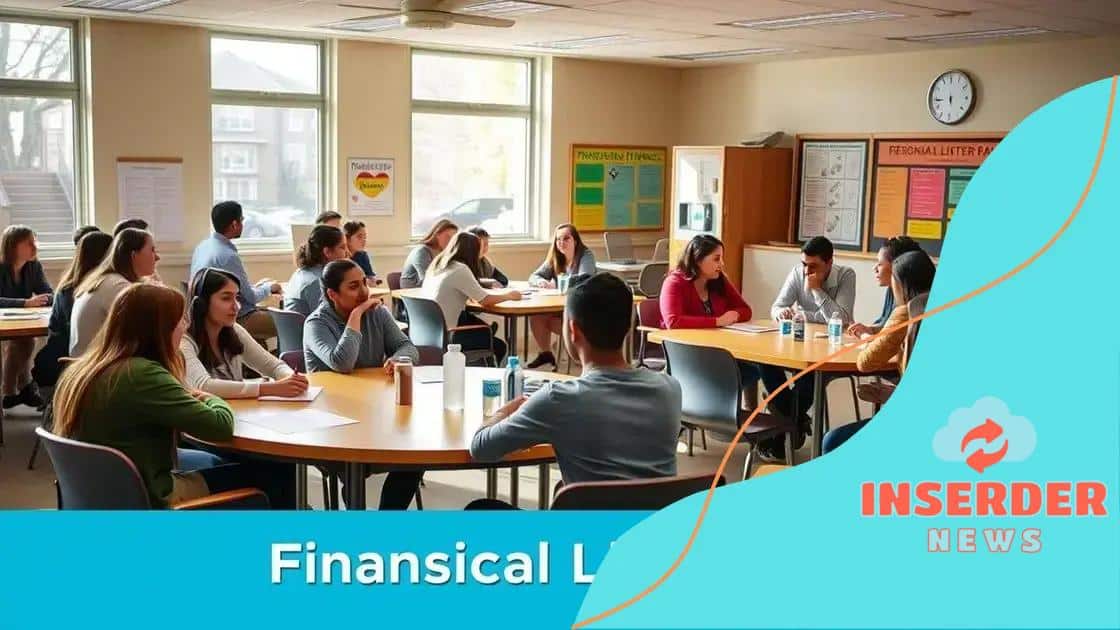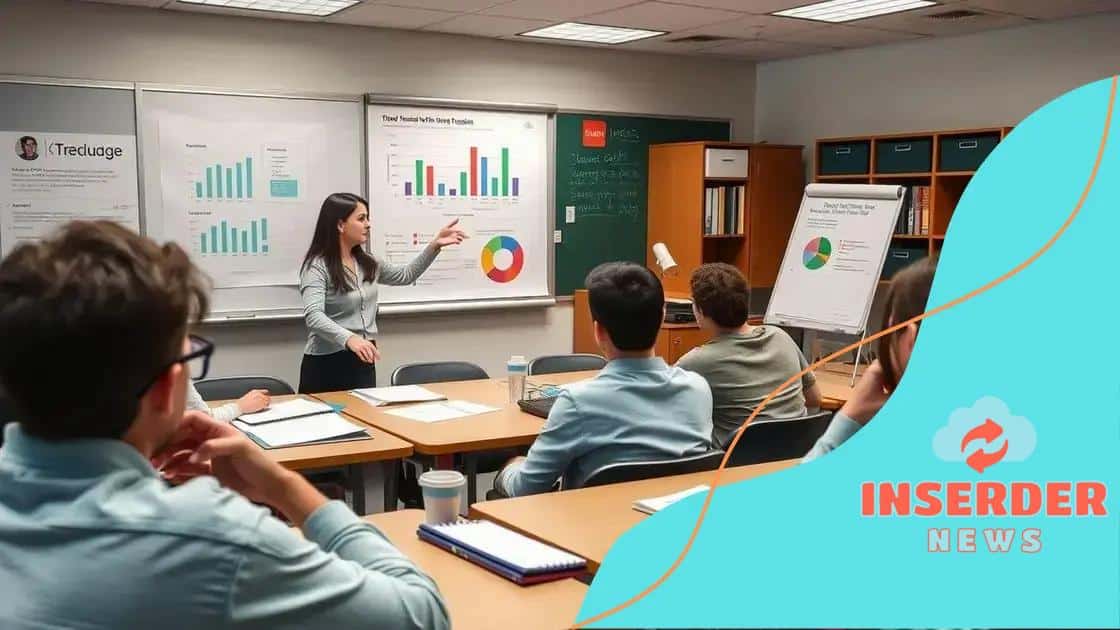How to incorporate financial literacy into university courses

Incorporating financial literacy into university courses equips students with essential skills like budgeting, investing, and managing debt, enabling them to make informed financial decisions in their personal and professional lives.
How to incorporate financial literacy into university courses is a vital question for educators aiming to equip students with essential life skills. Navigating the complexities of finance can be daunting, but universities have the opportunity to make a meaningful impact.
Understanding the importance of financial literacy
Understanding financial literacy is essential for students preparing for their future. It helps them make informed decisions about money management. From budgeting to investing, financial literacy covers many important topics. With the right knowledge, students can navigate the complexities of personal finance effectively.
Why Financial Literacy Matters
Financial literacy impacts daily life. It gives students the tools to manage their finances wisely. For instance, understanding how to budget can prevent debt and encourage saving.
Key Benefits of Financial Literacy
- Improved money management skills
- Increased confidence in financial decisions
- Ability to plan for the future
- Reduction of financial stress
When students grasp the concepts of financial literacy, they not only prepare for their careers but also for life. Knowing how to invest in the stock market or save for retirement can set them ahead of peers who lack this knowledge. Furthermore, students who are financially literate often make sound financial choices that lead to a stable life.
By instilling financial literacy in university courses, educators equip students with lifelong skills. They’ll learn about credit scores and loans, making this complex information approachable. Understanding these topics is crucial as they may face student loans after graduation.
How Universities Can Teach Financial Literacy
Integrating practical examples can make learning effective. For instance, role-playing scenarios help students experience financial decision-making firsthand. Workshops and seminars led by professionals can also reinforce learning.
Using real-life applications engages students and allows them to see the relevance of the material. Students are more likely to retain knowledge when they understand its impact on their lives.
Key concepts that should be included in courses
When teaching financial literacy, it’s crucial to include key concepts that resonate with students. Understanding these fundamental ideas prepares them for real-life situations. Topics like budgeting, investing, and managing debt are vital in today’s world.
Essential Topics in Financial Literacy
By covering a variety of concepts, educators can engage students. These topics can empower them to make informed financial choices. Some essential areas to include are:
- Budgeting: Teaching students how to track their income and expenses helps them plan effectively.
- Saving: Understanding the importance of saving for emergencies can lead to financial stability.
- Investing: Introducing the basics of stocks and bonds expands their knowledge about growing wealth.
- Debt Management: Students must learn how to handle credit cards and loans responsibly.
Each of these concepts plays a significant role in developing a well-rounded understanding of personal finance. For instance, when students learn about budgeting, they gain skills that allow them to manage their finances throughout their lives.
Real-World Applications
Connecting lessons to real-world scenarios helps students see their relevance. For example, discussing how to use a credit card wisely can prevent future financial troubles. Teachers can create assignments that allow students to practice creating budgets or planning for future expenses.
Financial literacy courses can also emphasize the value of financial technology. Using budgeting apps or online investment platforms provides hands-on experience. This combination of theoretical knowledge and practical application enhances learning effectiveness.
Moreover, collaborating with local financial institutions can provide valuable resources. Guest speakers and workshops can offer insights into personal finance, making learning more enriched. This approach facilitates interactive discussions that help students digest complex information and see the connections to their own lives.
Effective teaching methods for financial topics

Effective teaching methods for financial topics can make a significant difference in how well students understand financial literacy. Engaging techniques help students connect with the material and retain important information. By using diverse approaches, teachers can enhance learning experiences.
Interactive Learning Techniques
One of the best ways to teach financial concepts is through interactive methods. For example, group discussions encourage students to share ideas and ask questions. This collaborative learning fosters critical thinking about financial situations.
Using Real-Life Scenarios
Incorporating real-life scenarios makes lessons relatable. Teachers can create case studies that simulate financial decisions students might face. Discussing topics like budgeting for college expenses or managing credit card debt helps students apply what they learn.
- Role-playing exercises: These activities allow students to practice handling financial situations.
- Simulations: Online platforms can help students experience investing and managing finances in a risk-free environment.
- Guest speakers: Inviting financial professionals to speak can provide valuable insights and motivate students.
Another effective method is integrating technology into lessons. Using apps and online resources can engage students in a format they are comfortable with. Learning through platforms that provide budgeting tools or investment simulations makes financial literacy accessible and enjoyable.
Additionally, incorporating games can enhance the learning experience. Financial games that challenge students to make budget decisions or invest wisely can make learning fun. This interactive approach can create a positive environment for discussing potentially stressful subjects like finances.
Assessment and Feedback
Regular assessments help gauge students’ understanding of financial topics. Quizzes, presentations, and group projects can provide insight into their learning progress. Feedback is essential, as it guides students toward improving their skills.
Promoting a culture of open communication encourages students to ask questions and explore financial subjects more deeply. By establishing a safe space for discussion, educators can help students feel more confident in their financial knowledge.
Integrating real-life scenarios into the curriculum
Integrating real-life scenarios into the curriculum is essential for teaching financial literacy. When students encounter practical examples, they can relate lessons to their own lives. This approach makes the material more engaging and memorable.
Real-World Applications
Using real-world applications helps students understand financial concepts better. For instance, discussing how to create a personal budget based on a student’s lifestyle makes the lesson relevant. Students can learn about income sources, expenses, and savings goals that fit their lives.
- Case studies: Analyzing real financial situations, such as managing college debt, can provide valuable insights.
- Simulations: Creating mock financial scenarios lets students practice decision-making without real-world consequences.
- Guest speakers: Financial experts can share their experiences and discuss challenges that young adults face.
When educators incorporate these methods, they promote critical thinking. By examining different outcomes and consequences, students learn how to approach similar situations in their own lives. This experiential learning is vital for building long-term financial skills.
Hands-On Projects
Hands-on projects offer a unique way to engage students. For example, assigning a project where students plan a mock investment portfolio teaches them about risk and reward. They can research various investment options and analyze potential returns.
Students can also participate in budgeting exercises, where they must allocate a fictional budget for living expenses. This task helps them understand the importance of prioritizing needs versus wants. Moreover, they learn to make choices that align with their financial goals.
Incorporating community partnerships can further enhance learning. Collaborating with local banks or financial advisors allows students to gain insights from professionals. These partnerships can lead to workshops or seminars, increasing student engagement and providing practical knowledge gained from the community.
Assessing student comprehension and skills
Assessing student comprehension and skills in financial literacy is essential for understanding their learning progress. Effective assessment methods help educators identify areas where students excel or need improvement. Various approaches can be implemented to ensure comprehension.
Multiple Assessment Methods
Using different assessment methods can provide a well-rounded view of student understanding. For example, written quizzes can test knowledge of key terms and concepts. Additionally, group projects allow students to work together and apply their learning to real-world scenarios.
- Quizzes: Quick assessments help gauge retention of financial concepts.
- Presentations: Students can demonstrate their understanding of specific topics by presenting to their peers.
- Peer evaluations: Allowing students to assess each other’s work fosters collaboration and critical thinking.
Incorporating self-assessment also encourages students to reflect on their skills. Providing them with rubrics can help them understand what is expected and how they can improve.
Formative and Summative Assessments
Using both formative and summative assessments gives a complete picture of student learning. Formative assessments, like quizzes and homework, provide ongoing feedback throughout the learning process. In contrast, summative assessments, such as final projects or exams, evaluate students’ overall understanding at the end of a unit.
Feedback is crucial in these assessments. Providing timely and constructive feedback helps students understand their strengths and areas for growth. Furthermore, it encourages a growth mindset, motivating students to keep improving.
Engaging students in their assessment process promotes accountability. By discussing performance with them, teachers can guide discussions that help clarify misunderstandings. This two-way communication allows educators to tailor instruction to meet students’ needs effectively.
Real-World Applications in Assessments
Incorporating real-world applications in assessments can enhance learning. For instance, asking students to create a budget for a simulated event challenges them to apply their skills practically. Similarly, presenting a financial plan for an imaginary business encourages them to think critically.
Moreover, these assessments can be performed individually or in groups, allowing students to learn from one another. By evaluating their peers, they can gain diverse perspectives on financial literacy.
FAQ – Frequently Asked Questions about Financial Literacy in University Courses
Why is financial literacy important for university students?
Financial literacy is essential for university students as it equips them with the skills to manage their finances, make informed financial decisions, and prepare for their future.
What are effective methods for teaching financial literacy?
Effective teaching methods include interactive learning, real-life scenarios, hands-on projects, and engaging guest speakers to make financial concepts relatable.
How can student comprehension be assessed in financial literacy courses?
Student comprehension can be assessed through quizzes, group projects, presentations, and regular feedback to monitor their understanding of key financial concepts.
What role do real-life applications play in teaching financial literacy?
Real-life applications allow students to apply financial concepts to practical scenarios, enhancing their engagement and understanding of the material.






